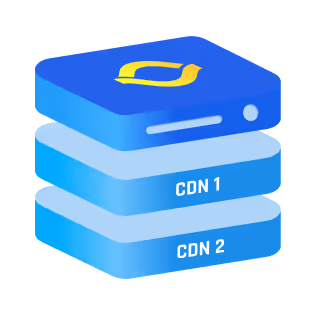Have you ever been in a busy restaurant where a person at the front decides which table you go to? That's a bit like a reverse proxy in the online world. Just as the restaurant person makes sure customers go to the right table, a reverse proxy guides your internet requests to the right place. This keeps websites and apps running smoothly, without you noticing.
Think of a reverse proxy as a helpful guide in the city of the internet. It's there to make sure that when you ask for a website or a service, you get it quickly and without trouble. Let's take a closer look at this handy tool and see how it works its magic in the background, making our online experience better.
What is Reverse Proxy?
A reverse proxy is like a middleman in the world of the internet. It sits between you, the user, and the web servers where websites are hosted. Imagine you're sending a letter to a friend in a big building. Instead of going directly to your friend's apartment, you give it to the receptionist at the front desk. The receptionist then decides which mailbox to put your letter in. That's similar to how a reverse proxy works.
When you type a website address into your browser and hit enter, your request travels through the internet. Here's where the reverse proxy comes in. It takes your request and decides which server on the back end should fulfill it. This is done based on various factors like the server's load, its health, and the type of content you're asking for.
But there's more to it. A reverse proxy doesn't just pass on requests. It can also modify them to make them better suited for the server or improve security. Sometimes, it caches (stores) responses. So, the next time someone asks for the same thing, it can provide the answer quickly without bothering the back-end servers. This makes everything much faster and more efficient.
{{cool-component}}
How Does a Reverse Proxy Work?
By quietly performing these steps for every request, a reverse proxy keeps modern web applications fast, resilient, and secure:
- DNS Resolution
The domain (example.com) resolves to the reverse proxy’s public IP rather than directly to an origin server. - TLS Handshake & Initial Checks
The client establishes a secure connection with the proxy. Here, the proxy can enforce rate-limits, bot detection, or WAF rules before forwarding anything further. - Request Routing & Load Balancing
- The proxy inspects the HTTP(S) request path, headers, and cookies.
- Based on a chosen algorithm (round-robin, least-connections, geo-affinity, etc.), it picks the healthiest, least-busy backend server.
- The proxy inspects the HTTP(S) request path, headers, and cookies.
- Optional Request Modification
The proxy may rewrite URLs, inject headers, or strip sensitive information—ensuring backend servers receive consistent, sanitized requests. - Caching & Acceleration
If the requested asset is already cached (e.g., an image or script), the proxy returns it immediately, skipping the origin server entirely. - Backend Server Response
When a cache miss occurs, the proxy forwards the request to the selected server, waits for the response, and may:
- Compress it (Gzip/Brotli).
- Inject security headers.
- Cache it for future identical requests.
- Compress it (Gzip/Brotli).
- Response Delivery to the Client
The optimized response travels back over the already-established secure connection. To the end-user, it looks as if a single server handled everything.
Difference Between a Proxy Server (Forward Proxy) and a Reverse Proxy
Here’s a quick rule of thumb:
- Forward proxy = “I don’t want sites to know who I am.”
- Reverse proxy = “I don’t want users to know where my servers live; or overload them.”
Key Functionalities of Reverse Proxies
Reverse proxies serve multiple key functions in web infrastructure, much like a versatile tool in a digital toolkit. Here are some of their most notable functionalities:
- Load Balancing: They distribute incoming network traffic across several servers. This ensures that no single server bears too much load, thereby improving application performance and preventing server overload. It's especially crucial for websites and applications with high traffic volumes.
- SSL Termination: Reverse proxies can manage SSL/TLS encryption and decryption for backend servers. This offloading of a resource-intensive task helps optimize server performance and simplifies SSL certificate management.
- Web Acceleration and Caching: These servers can store (cache) static content like images, stylesheets, and scripts. This reduces the load on backend servers and speeds up content delivery to users, enhancing overall website performance and responsiveness.
- Security and Access Control: Acting as a barrier between the public internet and internal servers, reverse proxies can implement security measures such as web application firewalls (WAFs) and access controls. This defends against web attacks and unauthorized access to sensitive resources.
- Content Compression: Before delivering content to clients, reverse proxies can compress it. This reduces bandwidth usage and speeds up page loading times, benefiting users with slower internet connections.
- Application Firewall: By filtering incoming traffic for potential threats and vulnerabilities, a reverse proxy with application firewall capabilities adds an extra security layer, protecting against common web application attacks.
- Single Sign-On (SSO): They facilitate SSO solutions, allowing users to access multiple applications with a single set of credentials, simplifying user authentication and improving the user experience.
- API Gateway: Often serving as API gateways, they manage and secure communication between clients and backend APIs. This includes enforcing authentication, authorization, and traffic management for API requests.
These functionalities highlight how reverse proxies optimize, secure, and manage web traffic in various scenarios, making them an essential component of modern web infrastructure.
Benefits of Using Reverse Proxies
The benefits of using reverse proxies are substantial, enhancing the overall functionality and security of web infrastructures. Here are some core advantages:
- Enhanced Performance and Reduced Server Load: Reverse proxies improve website loading times by caching content and balancing the load across multiple servers. This ensures no single server is overwhelmed, maintaining optimal performance levels.
- Boosted Security: They act as a shield between the internet and your backend servers, filtering out malicious traffic and preventing direct attacks on your servers. This is done through solutions like WAAP.
- Scalability and Flexibility: Reverse proxies facilitate easy scaling of web applications. They efficiently manage an increase in traffic, making it easier to add new servers or expand capacity.
- Global Server Load Balancing: By distributing user requests across different servers worldwide, reverse proxies reduce latency and improve user experience, especially for a geographically diverse audience.
- SSL Offloading: Handling SSL/TLS encryption and decryption reduces the load on backend servers, enhancing performance and simplifying SSL management.
- Insightful CDN Logs: When integrated with a CDN, reverse proxies provide detailed CDN logs. These logs offer valuable insights into traffic patterns, user behavior, and potential security threats. This data is critical for optimizing website performance and security measures. It's like having a detailed map of how users interact with your site, allowing you to make more informed decisions.
- Protection from DDoS Attacks: By hiding the IP addresses of your servers, reverse proxies protect your site from DDoS attacks, making it difficult for attackers to target your servers directly.
- Efficient Content Delivery: They ensure that content delivery is optimized by caching frequently requested resources, reducing the load on the origin servers and speeding up response times for the end-users.
Conclusion
In essence, reverse proxies not only direct traffic to the right servers but also enhance the overall online experience. From load balancing to SSL offloading, reverse proxies offer a suite of functionalities that are essential for high-performing, secure, and scalable web applications.
FAQs
What is a reverse proxy, and how does it act as a “middleman”?
A reverse proxy server sits between the internet and your origin servers. Unlike a proxy and proxyproxy site that hides the client, it masks the backend, inspects each request, then forwards it to the healthiest server before returning an optimized response.
What key functionalities do reverse proxies offer?
They provide load balancing, SSL offload, caching, compression, WAF protection, SSO, and API-gateway features. In the proxy vs reverse proxy comparison, these extra tools make the reverse proxy essential for performance and security.
What are the main benefits of adding a reverse proxy?
Lower latency, stronger security, simplified certificate management, and rich traffic analytics. Compared with forward vs reverse proxy roles, the reverse variant also hides server IPs and mitigates DDoS attacks.
How do reverse proxies speed up websites?
By caching static assets, compressing responses, and reusing upstream connections, they cut bandwidth and server CPU, delivering pages faster even during traffic spikes.
Can reverse proxies aid scalability?
Yes. Because the proxy abstracts public traffic from individual nodes, you can add or remove servers on the fly; health checks ensure only live instances receive traffic, letting the stack grow significantly.



.png)
.png)
.png)






